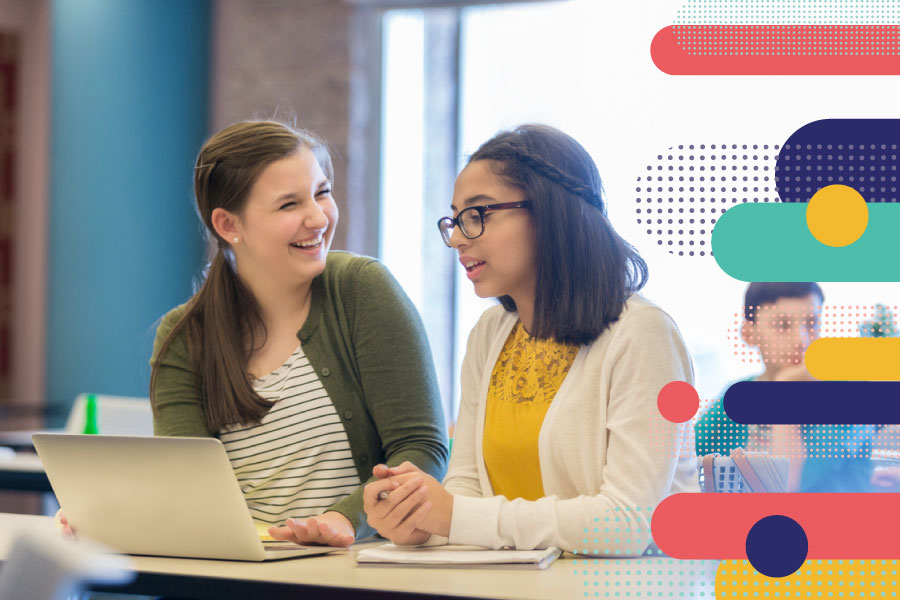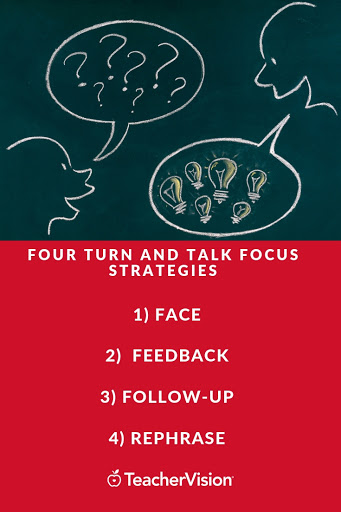Turn and Talks is a best practice for supporting students to pause during your lesson and share with a partner. In this blog post, Julie Mason shares a strategy for taking your turn and talks to the next level in order to support students to develop essential communication skills.

What is a Turn and Talk?
In case you don’t already use them, a Turn and Talk is an oral communication strategy that provides students with scaffolded interactions to formulate ideas and share their thinking with another student. Students have a chance to share their thinking in a low-risk setting.
They Lower The Stakes
We don’t always have time for students to engage in a whole-class discussion. We also can’t easily ensure equitable participation when everyone in the class is part of the dialogue. The stakes are also lowered when a conversation is between two students rather than between 30 students. Students who may not feel comfortable speaking up in front of the entire class might feel at ease talking to their elbow partner.
They Save Time
Because we have a limited amount of time that we can spend on each subject in an elementary classroom and our class periods often feel too short, we are always looking for teaching strategies that save time. Turn and Talks can take as little as two-three minutes. They can be as simple as providing students an opportunity to summarize what they have learned so far in the lesson to asking a question that they have while the lesson is taking place.
They Provide Students With An Opportunity To Practice Oral Communication Skills
I would argue that one of the most important skills our students need to develop are oral communication skills. In our complex world and diverse society, it is essential to listen and learn from others and be able to ask thoughtful questions and build on each others’ ideas. Our curriculums are vast, and we have a lot of standards to cover. However, if we don’t prioritize these skills and provide students with the opportunity to practice, we can’t expect them to know how to Turn and Talk.
Four Turn and Talk Focus Strategies
If I could only hang up one anchor chart in my classroom, this would be it. Students often think that when they turn and talk that their primary task is to talk. However, there is more to a conversation that the words exchanged. Body language and tone are equally important, especially for the student who is listening. By making these strategies visible in your classroom, you are reminding the students of your expectations for a turn and talk and supporting them with a scaffold to guide their turn and talk.
Face: Look your partner in the eyes, lean in and smile.
Feedback: Nod your head. Give caring-cues.
Follow-Up: As a question. Try to find out more.
Rephrase: Try saying back what you heard your partner say.

How To Use The Turn and Talk For Feedback Strategy:
I like:
It is important that a conversation between two students where they are giving and receiving feedback starts with the positive. Often students aren’t specific enough. A student might simply say, “ I liked it.” The reason we ask students to engage in a feedback loop is so they have some actionable next steps to continue or revise their work. When we model for students the importance of saying not only, “I liked it,” but “I liked it because______,” we are helping students learn essential oral communication skills.
I wish:
The language used here is very important. Using “I wish” is very different than using, “you should.” Students often take constructive criticism personally. We don’t want our students to think that their work is bad or wrong. We don’t want our students to feel defeated by feedback; we hope they feel empowered by feedback. It is important that students are both specific and thoughtful in how they phrase their wish. Modeling this process for them can help them better understand the body language, the tone of voice, and the word choice that makes giving someone constructive feedback more supportive.
I wonder:
This is the part of the turn and talk where students have the opportunity to practice engaging in a conversation. A Turn and Talk can often look a lot like parallel play. Students are sitting next to each other. One student talks, and then the other student talks, but there isn’t necessarily a connection between the two statements. I believe that we have to explicitly teach students how to initiate and continue a meaningful conversation where both people feel seen and heard. Students often need support with this. Providing them with specific phrases can work as a strong scaffold, which will eventually, and with practice, become intuitive.
Provide Students With Accountable Talk Stems
If I was going to teach on a deserted island and could only take one teaching resource with me, this would be it. We often assume that students know how to have a meaningful conversation when they come to our class. However, I have learned from experience that oral communication skills need to be explicitly modeled and taught. Students need time in class to practice these skills, so they become intuitive and automatic. Here is a list of stems you can share with your students as they engage turn and talks.
For additional resources that support students to develop strong communication skills, check out: Tips and Strategies For Making Student Thinking Visible and Think, Pair, Share Cooperative Learning Strategy.
Do you use Turn and Talks in your classroom? Share with us on Instagram, Facebook, Twitter, and Pinterest.


